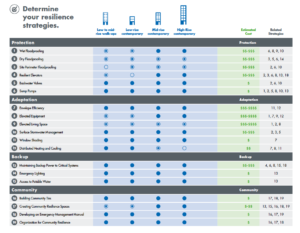Long Live Your Community: Building an Enduring Resilience Takes More Than Stronger Buildings
Michael, Florence, Harvey, Willa, Camp Fire, and Maria are no longer just names. They are reminders of natural disasters that dismantled communities and left devastation in their wake. This is just a partial list of what has hit our shores in the past two years, and they won’t be the last.
The following blog was written by Caila Prendergast, a Program Associate working on the Building Clean Program.
Estimated property damage from natural disaster from 2017-2018 was nearly $400 billion, but that is the least of the storms’ impacts. During Hurricane Harvey, damaged oil refinery equipment led to an estimated one million pounds of chemicals such as benzene and sulfur dioxide being released into the air, rates far higher than deemed acceptable. Flood waters were permeated with sewage and hazardous chemicals from damaged chemical manufacturing plants. In California, the thick smoke full of dangerous substances was released as homes and other buildings burned.
As the frequency and severity of natural disasters impact people and communities in a larger way than ever before, resiliency in the built environment is being recognized as a crucial element in mitigating these impacts. Especially since those who lose the most are often the ones who had the least to begin with.
Substandard housing only makes destruction more likely, adds to the hazardous substances entering the air and water, and increases the threat of personal injury. In low-income communities, whose pre-existing inequality compounds in the aftermath of a natural disaster, an already fragile existence falls apart as buildings are condemned rather than repaired and residents face homelessness rather than hope for a quick recovery.
Building resilience involves building a home that is protected from extreme weather events, able to adapt to changing circumstances, and equipped with backup equipment in the case of failure. This includes improving envelope efficiency, flood proofing, installing backup power, and ensuring potable water. It also means using healthier building materials to minimize the danger of chemical releases from buildings during a natural disaster.
But building resilience is not just a reaction to short term needs revolving around housing. A roadmap for building resilience in multifamily housing from Enterprise Green Communities checks off the steps to take to prepare the building. But the advice tackles more than just physical structures .
.
Community resilience is another important aspect and involves strengthening neighborhood ties and organizing in the face of disaster both before and after it strikes.
“Acting for long-term resilience within the timeframe of immediate recovery will allow the region to address the many forms of recovery—from economic, to structural, to environmental and physical,” notes a report examining the aftermath of Harvey in Houston. “Within this action, though, we should empower communities to shape the process for themselves, invest in mitigation and resilience in all areas of the region, not just those hit by Harvey, and accept that challenges preventing resilience are different in every community.”
